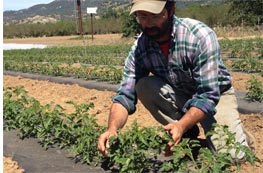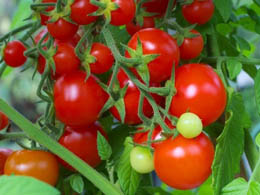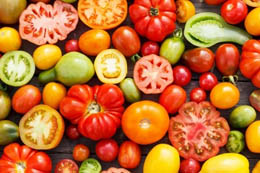Tales of Tomato Season
- By Seth Wright
- Reading Time: 5 mins.

As I drive around the valley, everywhere I look, tomato plants are quickly growing larger. Watching them grow is torture because tomatoes have been on my mind since they went out of season early last fall. The funny thing is, I didn’t even like tomatoes until I moved to the Capay Valley last August.
That’s because until then I lived in a cold, windy, high-altitude desert otherwise known as Wyoming. If you can get a tomato to grow at high altitude, it is tragically, ludicrously small. And you can forget buying tomatoes from the local grocery store. They have the flavor profile of a cardboard box.
However, luckily for you (and for me) tomatoes that grow here in the Valley aren’t pitiful, flavorless Wyoming tomatoes. They are the best tomatoes I have ever tasted. Anxious to learn more about them, I sat down with Full Belly Farmer and tomato expert Andrew Brait.
ME: Tomatoes are finally starting to ripen. When does tomato season usually start at Full Belly?
 Andrew Brait: Well, arguably the first week in July really is sort of the start of the typical tomato season. We’ll start picking the very first ones then: typically cherry tomatoes, a few Early Girls and a few early heirlooms. However, everything is about three weeks ahead of schedule this year.
Andrew Brait: Well, arguably the first week in July really is sort of the start of the typical tomato season. We’ll start picking the very first ones then: typically cherry tomatoes, a few Early Girls and a few early heirlooms. However, everything is about three weeks ahead of schedule this year.
ME: Is there a lot of prep work you do earlier in the year to start getting ready for tomato season?
AB: Tomato season is pretty much a ten-month season. You start ordering seed in December, and then in January, you are planting tomatoes in the greenhouse. By March tomatoes start getting transplanted out into the fields. In May you are staking and tying them, and by June you are starting to think about early, early picking. During July, August, September, and October you are pick until the rain sets in. They are an important enough crop that we end up putting a lot of attention into them.
ME: How does the weather and soil here in the Capay Valley contribute to making a great tomato?
Want farm-fresh fruit?
We've got you covered.AB: One of the things that the Capay Valley has is a wet season and a dry season. If you are a tomato producer east of the Mississippi, it essentially precipitates every week of the year, and that’s a big issue for tomatoes. It can cause cracking, fungus, and disease issues that don’t really happen here because it doesn’t rain when the tomatoes are ripening. It’s a fairly ideal climate for tomatoes in the Capay Valley. They thrive here.
ME: What kind of problems do you face when growing a crop of tomatoes organically?
AB: Well, a couple of big things. Tomatoes have pretty exact nutrient requirements. You have to make sure you understand how those nutrients are going to be available as the plant grows. As it gets older and tries to produce fruit, it gets tired and is less efficient in terms of how it cycles in nutrients, so nutrients are a big thing. Of course, insect and disease control are other big issues. We stake all of our tomatoes, and that creates challenges as to how you effectively get any kind of protection or probiotic amendments into the plant. We built ourselves a special spray rig to meet those challenges.
 ME: How many varieties of tomato do you grow here at Full Belly?
ME: How many varieties of tomato do you grow here at Full Belly?
AB: Probably 25 plus varieties. We have cherry tomatoes that make up six or eight different varieties. Some heirlooms probably make up 15 to 20, and then there are Roma and slicer types that make up another four or five varieties.
ME: Why did you choose these varieties?
AB: You mean why those 25 out of the 250,000 tomatoes that you could possibly choose from? Well, we do a lot of trialing. We are always trying new varieties. However, the number one criterion for all varieties is flavor. Then we start looking at cultural characteristics, such as how well do they do in terms of yield, disease resistance, and propensity to cracking. Also, its distinctiveness is an important factor because we have a very strong market for mixed heirlooms. We are always looking for something that makes a mixed heirloom pack unique.
ME: Do you have a favorite variety? Why is it your favorite?
AB: Absolutely, my favorite variety is called Gold Medal. It’s a Marvel Stripe type. They are a very large one to one and a half pound striped fruit that has kind of a perfect balance of acid to sugar. Also, it’s just drop-dead gorgeous. When you start slicing them up, people are just like “wow!”
ME: Are any of the varieties you grow good for canning or sun drying?
 AB: Yes. The Red Slicers, Romas, and Early Girls do the best for sun drying. For sauce, we’ve been playing around with a bunch of different varieties. But I have to say; these good old-fashioned Romas are the best for sauce because they have less water, more solids, and great flavor.
AB: Yes. The Red Slicers, Romas, and Early Girls do the best for sun drying. For sauce, we’ve been playing around with a bunch of different varieties. But I have to say; these good old-fashioned Romas are the best for sauce because they have less water, more solids, and great flavor.
ME: What are some indicators of a great, flavorful tomato?
AB: Well, that is the great twenty-first-century tomato conundrum. We all have known that beautiful, stunning tomato that you see at the supermarket. It is blemish-free and has a nice red color, but then you bite into it, and it tastes like literally the box it was shipped in. That is a function of tomatoes that are picked green. Some conventional farms pick tomatoes just as they are starting to break color. They are not a vined ripened fruit, so they are not as good. However, the way you can tell a tomato has been vine-ripened is by touching it. The tomato should have full color and some give, as well as a tomato smell.
ME: In your opinion, what is the best way to prepare a tomato?
AB: I am super, super excited about these basic Italian salads which are just sliced tomatoes, basil, a little bit of olive oil, balsamic vinegar, maybe some crushed pepper, and mozzarella cheese; just something pretty accessible.
Get tips for your office
Be an office hero!This article is written by Farm Shop Team Member Seth Wright, courtesy of Capay Valley Farm Shop


